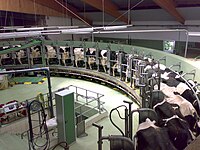
Photo from wikipedia
Abstract This experiment evaluated the effects of providing artificial shade during summer on activity, behavior, and growth performance of pregnant grazing beef heifers. Thirty-six black-hided Angus and Angus crossbred pregnant… Click to show full abstract
Abstract This experiment evaluated the effects of providing artificial shade during summer on activity, behavior, and growth performance of pregnant grazing beef heifers. Thirty-six black-hided Angus and Angus crossbred pregnant heifers [418 ± 9 kg body weight (BW); approximately 90 d of gestation] were stratified by breed, blocked by BW, and allocated to 12 “Pensacola” bahiagrass pastures (Paspalum notatum Flüggé; 1.3 ha, n = 3 heifers/pasture) with or without access to artificial shade (SHADE vs. NO SHADE; 6 pastures each) for 7 wk during summer. The shade structures were composed of shade cloth (11 × 7.3 m length, 2.4 m height: 26.8 m2 of shade per heifer). Shrunk BW was recorded on enrollment (day 0) and week 7 (day 47), whereas full BW was obtained on week 2 (day 14), 4 (day 28), and 6 (day 42) to assess average daily gain (ADG). Vaginal temperature was recorded for five consecutive days during weeks 1, 3, 5, and 7 using an intravaginal digital thermo-logger, and individual GPS devices were used to quantify the use of shade for an 8-h period. Activity was monitored using automated monitoring devices (HR-LDn tags SCR Engineers Ltd., Netanya, Israel) through the experimental period. Vaginal temperature was lower (P < 0.01) for heifers in the SHADE compared with heifers in the NO SHADE treatment from 1200 to 1600 h and 1100 to 1900 h for weeks 1 and 3, respectively. Heifers in the SHADE treatment spent 70% of the 8-h period evaluated under the shaded structure. Provision of shade increased (P < 0.01) daily lying time (11.4 ± 0.2 vs. 10.3 ± 0.2 h/d) and standing bouts per day (P < 0.01; 12.6 ± 0.4 vs. 10.8 ± 0.4 bouts/d), whereas it reduced (P < 0.01) standing bout duration (61.6 ± 3.0 vs. 82.9 ± 3.0 min/bout) relative to heifers without access to shade. The interaction between treatment and hour affected (P < 0.01) daily rumination time because heifers with access to SHADE had greater rumination between 1000 and 1200 h. Although ADG tended (P = 0.08) to be greater for the heifers in the SHADE treatment (0.20 vs. −0.02 kg, respectively), the access to shade did not (P = 0.79) affect the final BW. In conclusion, providing artificial shade during summer to pregnant grazing beef heifers was effective in reducing vaginal temperatures and exerted changes in heifer behaviors that translated into slight improvements in growth performance.
Journal Title: Translational Animal Science
Year Published: 2021
Link to full text (if available)
Share on Social Media: Sign Up to like & get
recommendations!